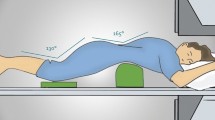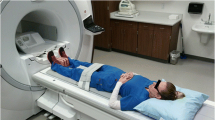Abstract
Purpose
This study aimed at describing the anatomy of the zona orbicularis (ZO), based on magnetic resonance arthrography (MRA) and magnetic resonance imaging (MRI) scans and to assess the presence of synovial folds in relation to the ZO.
Methods
A retrospective review was performed using consecutive hip and pelvic MRA and MRI examinations from our institution. We identified 25 normal scans of each variety. Patients were scanned in a neutral hip position and 3D FIESTA sequence images were included in a number of cases. Using electronic callipers, measurements were obtained of the ZO thickness and of the location of the ZO with respect of the femoral head and neck.
Results
On MRA, the ZO appeared as a horseshoe in 18/25 patients, being absent anteriorly. On MRI the ZO was less consistent and absent in 12/25 posteriorly, in 8/25 inferiorly and in 2/25 anteriorly. Where present, the ZO usually coincided with the boundary of femoral head sphericity and the narrowest point of the isthmus of the femoral neck. The medial synovial fold was identified in all MRA studies (25/25).
Conclusions
The ZO of the hip is most consistently identified when the joint is distended and in approximately 75 % of cases appears as a horseshoe-shaped structure. Superiorly, the ZO is aligned perpendicular to the long axis of the femoral neck. The ZO twists from postero-lateral to antero-medial as it moves inferiorly. Our findings are consistent with the hypothesis that the ZO functions as a ring that resists femoral head distraction and contributes to dynamic circulation of synovial fluid.






Similar content being viewed by others
References
Blankenbaker DG, Davis KW, De Smet AA, Keene JS (2009) MRI appearance of the pectinofoveal fold. AJR Am J Roentgenol 192(1):93–95
Byrd JW (2006) Hip arthroscopy. J Am Acad Orthop Surg 14:433–444
Domb BG, Giordano BD, Philippon MJ (2013) Arthroscopic capsulotomy, capsular repair, and capsular plication of the hip: relation to atraumatic instability. Arthroscopy 29(1):162–173
Field RE, Rajakulendran K (2011) The labro-acetabular complex. J Bone Joint Surg Am 93(2):22–27
Gray H (1918) Anatomy of the human body, 20th edn. Lea & Febiger, Philadelphia, Bartleby.com. http://www.bartleby.com/107/. Published May 2000. Accessed Feb 2010
Hewitt JD, Glisson RR, Guilak F, Vail TP (2002) The mechanical properties of the human hip capsule ligaments. J Arthroplasty 17(1):82–89
Ito H, Song Y, Lindsey DP, Safran MR, Giori NJ (2009) The proximal hip joint capsule and the zona orbicularis contribute to hip joint stability in distraction. J Orthop Res 27(8):989–995
Kapandji IA (2011) The hip. In: The physiology of the joints: lower limb, vol 2 6th edn. Elsevier, Edinburgh, pp 2-65
Latarjet M, Ruiz Liard A (2004) Articulación coxofemoral. In: Anatomía humana (spanish edition), 4th edn. Medica Panamericana, Buenos Aires, pp 706–745
Myers CA, Register BC, Lertwanich P et al (2011) Role of the acetabular labrum and the iliofemoral ligament in hip stability: an in vitro biplane fluoroscopy study. Am J Sports Med 39 suppl:85S–91S
Odgers PN (1931) Two details about the neck of the femur (1) The Eminentia. (2) The Empreinte. J Anat 65:352–362.3
Petersilge CA (2000) From the RSNA refresher courses. Radiological Society of North America. Chronic adult hip pain: MR arthrography of the hip. Radiographics 20 Spec No: S43–52
Rouviere H, Delmas A (2005) Articulaciones de la cintura pélvica. In: Anatomía humana-descriptiva, topografica y funcional (spanish edition), vol 3, 11th edn. Masson, Barcelona pp 361–372
Testut L, Latarjet A (2004) Articulación coxofemoral. In: Compendio de anatomía descriptiva (spanish edition), 11th edn. Masson, Barcelona, pp 132–135
Wagner FV, Negrao JR, Campos J et al (2012) Capsular ligaments of the hip: anatomic, histologic, and positional study in cadaveric specimens with MR arthrography. Radiology 263:189
Acknowledgments
The authors would like to thank Dr. Florian Posch for statistical guidance.
Conflict of interest
Each author certifies that he or she has not received any funding or financial support that might pose a conflict of interest in connection with the submitted article.
Author information
Authors and Affiliations
Corresponding author
Rights and permissions
About this article
Cite this article
Malagelada, F., Tayar, R., Barke, S. et al. Anatomy of the zona orbicularis of the hip: a magnetic resonance study. Surg Radiol Anat 37, 11–18 (2015). https://doi.org/10.1007/s00276-014-1300-z
Received:
Accepted:
Published:
Issue Date:
DOI: https://doi.org/10.1007/s00276-014-1300-z




